Hiring the right talent can boost sales, expand revenue streams, and create a harmonious workplace for all. In 2025, there are several new recruiting trends to look out for – recruiters are using a range of strategies to improve employer branding and bring in the right talent.
Here at Business2Community, we know what matters the most to your business. In this article, we’ll go through the latest recruitment trends that can refine your hiring strategies. Whether you’re a business owner looking to recruit or an HR professional curious about the industry, here is everything you need to know about.
Key Hiring and Recruiting Trends
- 43% of employers believe allowing recruits to work from home gave them a hiring advantage.
- HR managers found personal connections (34%) to be the most effective hiring strategy in 2022.
- In 2022, 37% of recruiters focused on hiring more ethnic minorities.
- 40% of hiring managers in 2023 were willing to customize individual welfare packages to attract talent.
- 95% of people believed AI would be more involved in the recruitment process in the future.
What are 2025’s Hiring and Recruiting Trends?
Each year, growing companies invest in sourcing new talent to meet their business goals but the job market is always shifting. HR leaders and job seekers have to stay informed about the latest hiring trends to beat the competition.
In 2022, 93% of employers were recruiting, up from 82% in the previous year, according to Monster Government Solutions. As the economy recovered from the pandemic, businesses began to get back on their feet and expand their scope of work.
On average, the cost per hire in 2022 reached $4,683 for companies, the Society for Human Resource Management (SHRM) found.
To make the most out of each hire, HR teams are utilizing various technologies and methods to draw in qualified applicants with the most impressive portfolios. Here are some of the hottest recruiting trends in 2025 you should know about.
1. Referrals are the Best Talent Acquisition Strategy
Competition is fierce in today’s labor market. Recruiters are relying on personal connections and job adverts to hire the right talent.
According to the Future of Work 2022 Global Report produced by Monster, HR leaders found the following channels to be the most effective in finding quality hires:
- Personal connections (34%)
- Job boards (29%)
- Candidate online portfolios (28%)
- Networking (27%)
- Career sites (27%)
- Company database (24%)
Personal connections included referrals from existing employees or internal recruiting.
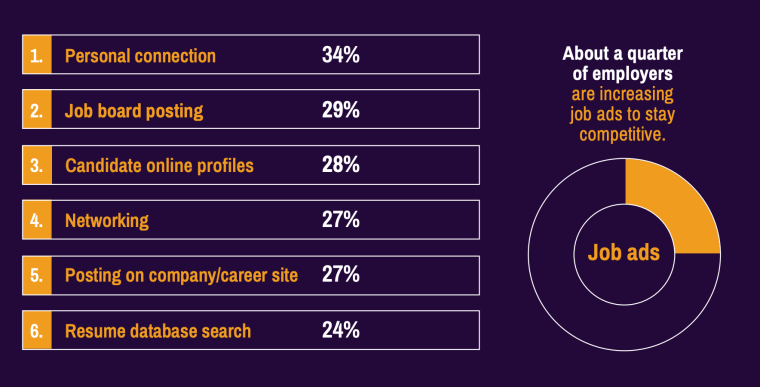
According to the 2023 Hiring & Job Search Outlook Report produced by iHire, just shy of half (49.5%) of employers preferred internal hiring. It simplified the onboarding procedures and reduced the possibility of bad hires. Internal talent are also more familiar with the company culture, thus integrating better with the company culture.
HireVue interviewed nearly 4,000 HR professionals in the US, the UK, and Australia to produce the Global Trends Report: the State of Hiring 2023.
In the survey, 48% of recruiters prioritized internal transfers among current employees to boost mobility within the company and ensure hiring quality. Employers could access an existing employee’s skills for a new role in under 30 minutes, saving costs and the human effort needed that would have been required for an outside candidate.
For job seekers, social media was a popular channel to find work in 2023, as a survey conducted by StandOut CV revealed. 79% looked for job listings on social media platforms, with freelancers favoring this strategy the most.
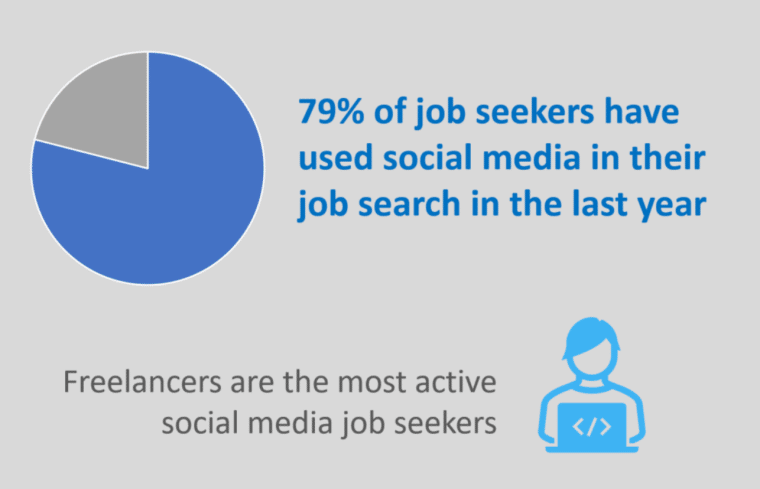
The most popular social media platforms for job searches were:
| Social Media Platform | %age Job Seekers Using |
| 90% | |
| Twitter/X | 57% |
| Glassdoor | 42% |
| 40% | |
| 29% | |
| YouTube | 22% |
2. Companies are Offering More Remote and Hybrid Positions
COVID-19 pushed companies to be creative and find alternatives to stay productive. Since the global pandemic, businesses have been more open to endorsing the increasingly popular remote-work style.
The same Monster report we mentioned previously also stated that 43% of employers believed a hybrid work model would thrive in the future. Roughly the same percentage stated flexible work schedules gave them advantages in recruiting and enriching employees’ mental well-being.
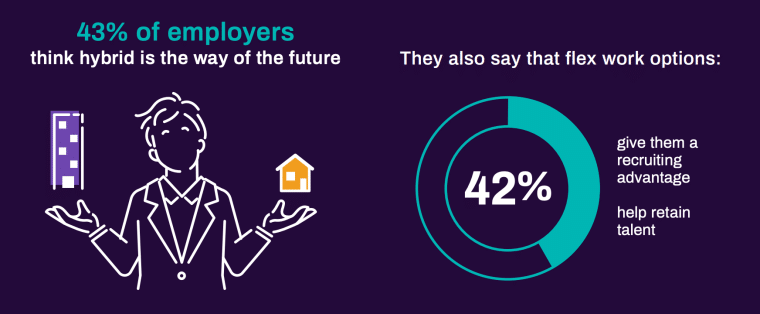
Furthermore, 53% of hiring managers allowed employees to work from home while 41% let them choose their work days and work hours.
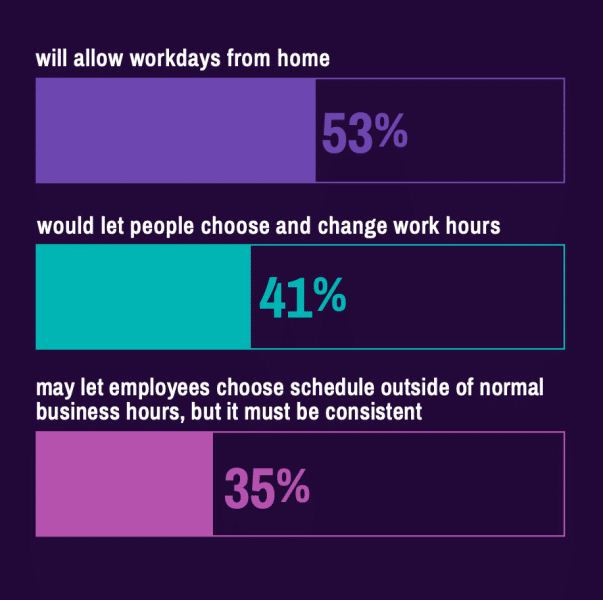
A 2021 McKinsey survey revealed that 30% of employees would consider changing jobs if their employers returned to a fully on-site model. Workers in Australia showed the highest percentage of favoring a remote model.
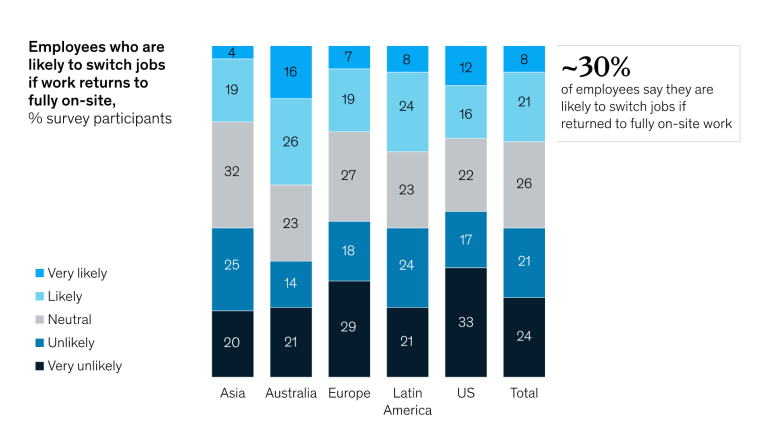
Over 50% of respondents wanted to work from home at least 3 days per week. Workers with young children under 5 (25%) showed the strongest interest in working remotely. Job hunters favored hybrid models that offered flexibility.
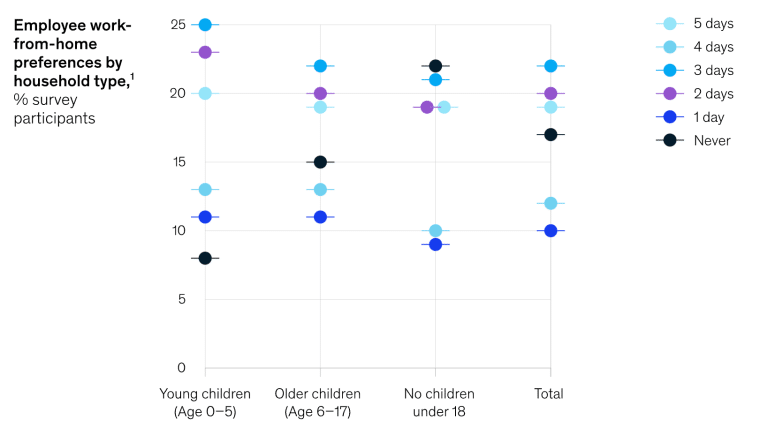
The pandemic may be over, but work-from-home is here to stay. Companies are actively advertising a remote model in the job description to attract qualified candidates. This makes it possible for businesses to drastically widen the scope of their talent search. A global workforce with diverse candidates refines employer branding and elevates the employee experience.
3. Hiring Managers are Making Past Work Experience a Priority
Compared to a degree in a top-ranking university, recruiting professionals are more interested in job experience.
The World Economic Forum (WEF) published the Future of Jobs 2023 Report, covering major factors that influenced hiring which included:
- Past work experience (71.3%)
- Skill assessments (46.6%)
- University degree (44.9%)
Recruiting teams preferred to compare top candidates’ work experience to get the most relevant and quantifiable metrics.
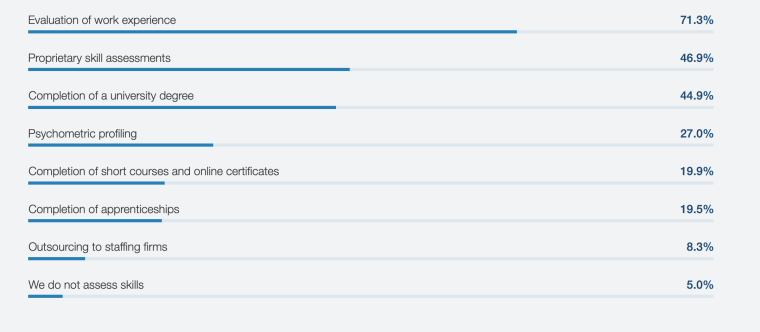
LinkedIn data shows that, in 2023, 25% of US job listings did not require a university degree and the volume of these open positions jumped by 30% in the second half of 2022.
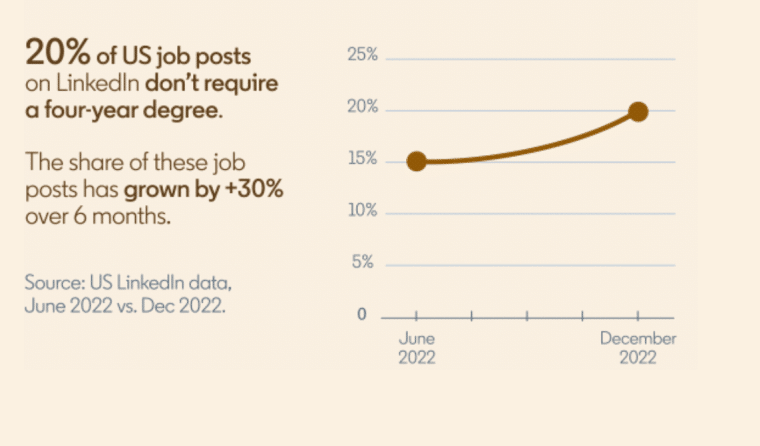
Hiring managers should be asking themselves whether the right talent needs to have attended university for the role they’re recruiting for and job seekers should be tapping into the experience-first trend by highlighting past achievements during the application process.
4. The Hiring Process is Going Digital
The pandemic forced most businesses to go online, even digitalizing the entire hiring process. In 2025, it is still one of the top recruiting trends as companies adapt to this new era of talent acquisition.
HireVue’s survey broke down several ways technology is being used in the recruitment process:
- Virtual interviews (70%)
- Standardizing online assessments (58%)
- Filtering CVs (53%)
- Automation (46%)
- Chatbots or text (40%)
- Generative AI (38%)
- Game-based assessments (32%)
Digitalizing the recruitment process makes data analysis easier for team members to review various KPIs like applications per opening and days to fill a role.
Indeed interviewed over 1,000 employers for its 2021 Hiring Trends Report. It found that over 93% of employers planned to continue incorporating virtual interviews in their hiring strategy.
Adopting virtual interviews in the talent acquisition process was an effective HR strategy. Companies said recruiting talent online had:
- Made it easier to keep track of the process (79%)
- Improved the overall candidate experience (77%)
- Sped up the recruiting process (74%)
With virtual hiring thriving, candidates can attend job interviews without traveling to a physical location. It brings up their willingness to apply and allows top talent to submit applications from further afield.
5. The Use of ATSs is Increasing
Applicant tracking systems (ATSs) maximize recruitment efforts by guiding qualified applicants through the process and refining the workforce planning process for businesses.
Jobscan’s 2023 Applicant Tracking System (ATS) Usage Report stated that 97.4% of Fortune 500 companies used ATSs in their talent acquisition process.
These Fortune 500 companies adopted ATSs to expand talent pools, automate comprehensive job listings, keep track of applications, generate analytical reports, and more.
ATSs play a significant role in helping businesses identify the skills needed for certain positions and customizing individual job ads.
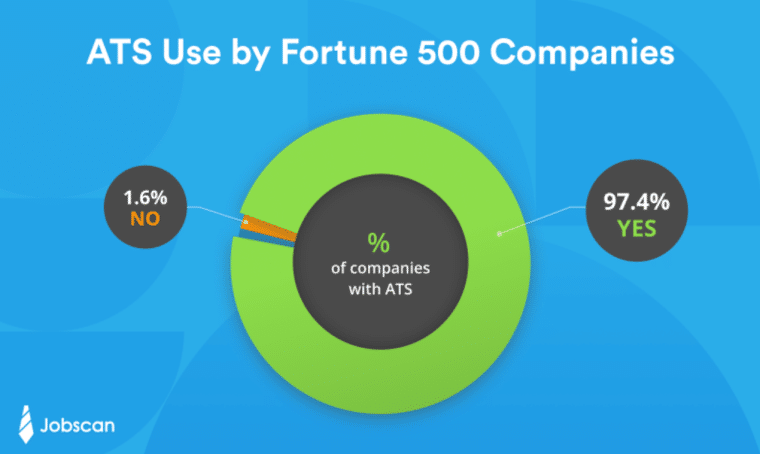
Here are the top ATSs used by Fortune 500 companies:
- Workday (38.5%)
- SuccessFactors (15.1%)
- Taleo (8.4%)
- ICIMS (7.7%)
- Oracle (5.3%)
- Phenom People (4.7%)
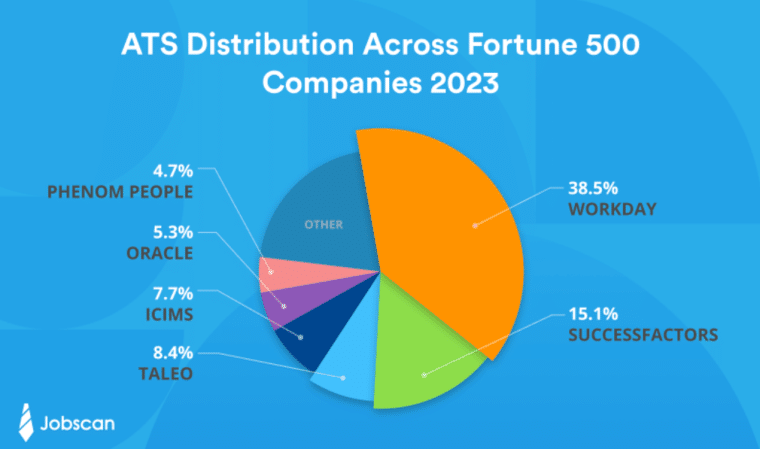
For the general ATS distribution landscape, Jobscan researched over 11,000 companies, including SMEs, and found these were the most popular:
- Greenhouse (18.2%)
- Lever (16.5%)
- ICIMS (15.9%)
- Workday (15.4)
- BambooHR (8%)
The differences between the general ATS distribution and the Fortune 500 companies distribution were likely due to the recruiting team budgets, scale, and limitations of different ATSs.
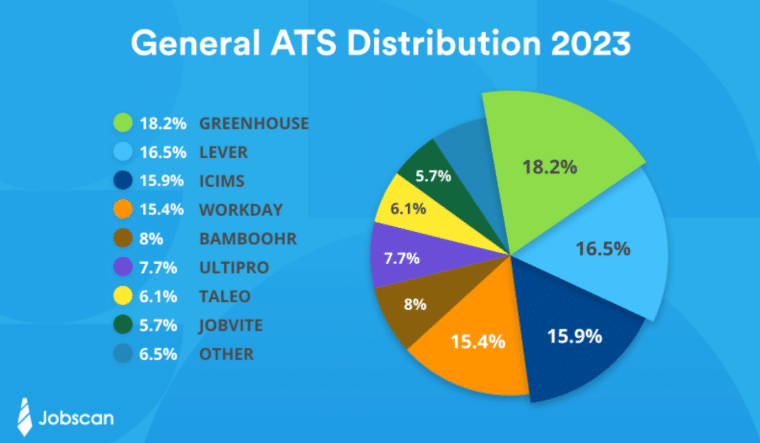
Having an efficient ATS setup can make talent acquisition much smoother. Candidates can get prompt feedback about the application and top talent can get in touch with business leaders directly for final interviews. Using one can also add to your employer branding as a tech-forward company.
Depending on your business needs, an ATS system is a cost-effective way to build a diverse workforce.
6. Job Hopping and Gaps on Resumes are No Longer Red Flags
Traditionally, hiring teams preferred hiring loyal workers with years of experience in the same company. But in 2025, more hiring professionals are viewing job hopping as part of the candidate’s strength.
Monster’s report found that fading red flags for recruiters in 2022 included:
- Gaps on resume (46%)
- Different geographical locations (42%)
- Job hopping (46%)
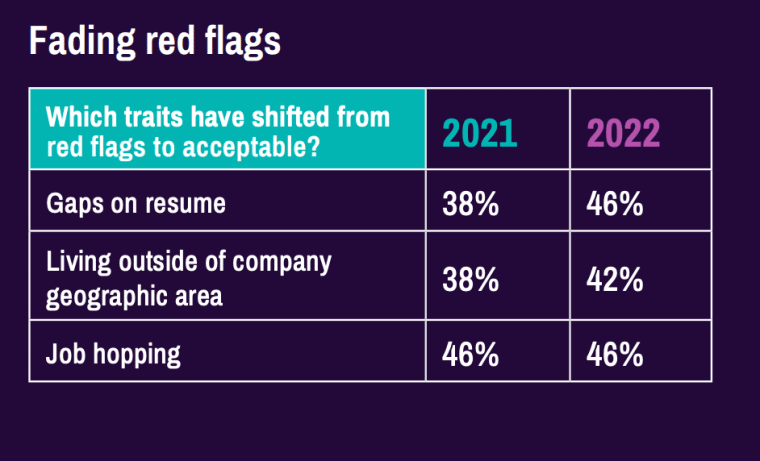
Organizations were more open to candidates with gap years on their resumes as they believed these traits brought diversified experiences.
Korn Ferry interviewed 4,000 full-time employees in the US and the UK in 2023 to understand their career visions. The survey found that 44% of workers believed their careers should be counted in months and not years. Another 24% said they considered changing jobs every 2 years to be normal.
7. The Tech Sector is Hiring More Professionals
Some industries are expanding faster than others, leading to more job opportunities. Overall, recruiters are hiring more professionals in the tech sector.
The Graduate Market in 2023 Research conducted by High Fliers looked into the number of graduate hires in different sectors to understand the global economy.
Major sectors with increased recruitment rates:
- Oil and energy (54%)
- Technology (40.4%)
- Consulting (36.1%)
- Accounting and professional services (31.5%)
- Engineering and industrial (30.5%)
There was a 14.5% rise in the number of hires in 2023 compared to the previous year. Most companies were increasing their budgets in operations.
Fresh graduates with relevant hard skills in these areas saw more opportunities and had higher bargaining power.
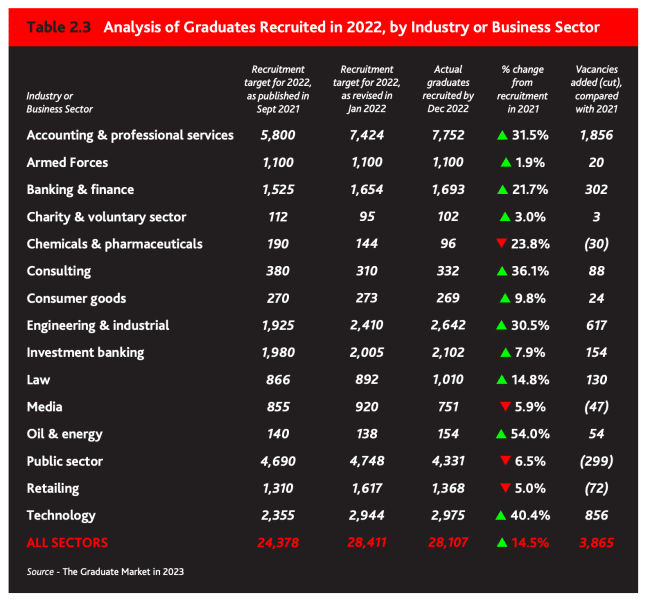
8. Recruiters are Valuing Soft Skills Like Creative Thinking and Analytical Thinking
Talents who can bring groundbreaking innovations are much-loved by recruiters. In 2025, strong creative thinking and critical analytical skills are the best soft skills to add to your resume.
The WEF research named the following key skills to be the most important for recruiters:
- Creative thinking (73.2%)
- Analytical thinking (71.6%)
- Technological literacy (67.7%)
- Curiosity and lifelong learning (66.8%)
- Resilience, flexibility, and agility (65.8%)
- Systems thinking (59.9%)
- AI and big data (59.5%)
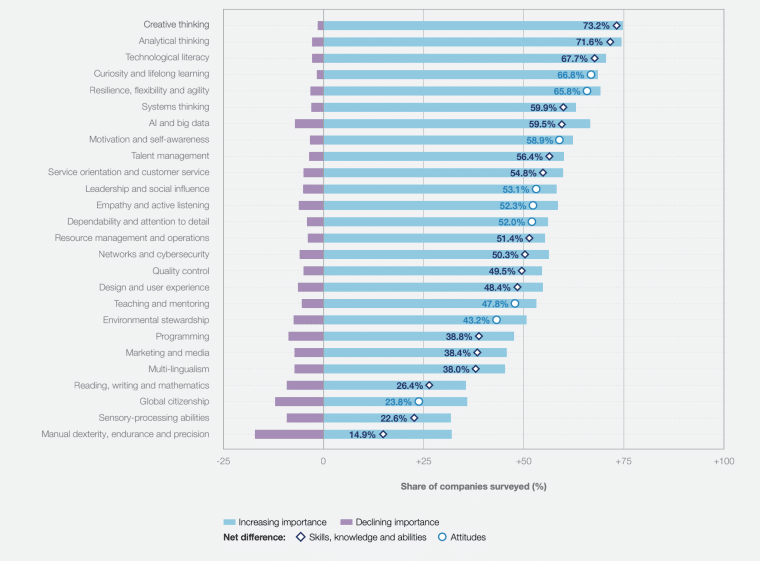
These skills were essential in the latest growing job positions, including AI and machine learning specialists, sustainability specialists, and business intelligence analysts. Candidates with a forward-thinking mind and a strong sense of the digital world were much more likely to be hired.
The report also looked into fields with declining new hires by studying the largest net jobs reduction over the last 5 years. Industries facing the largest job decline were data entry, administration, bookkeeping, and security guards. More and more companies were replacing these positions with AI to increase efficiency, reduce costs, and standardize the quality of services.
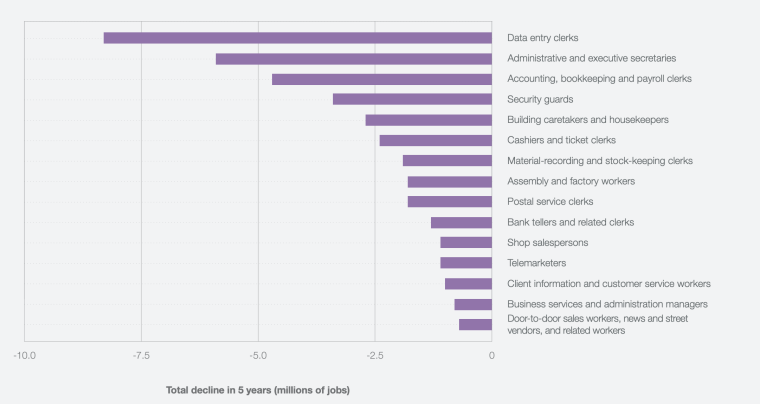
9. Employer Branding is Key
In today’s era, many job seekers are looking for a fruitful work environment that fosters growth and learning opportunities and recruiters must offer promising career paths with a strong employer brand to attract talent.
A caring, welcoming employer brand encourages more candidates to join and existing employees to stay.
Korn Ferry found that younger people tended to focus on value alignment. 73% of Millennials thought it was important to share the same company values for them to accept an offer, compared to just 63% of Baby Boomers.
82% of Gen Zers believed they could influence the company culture, aligning it with their values and visions.
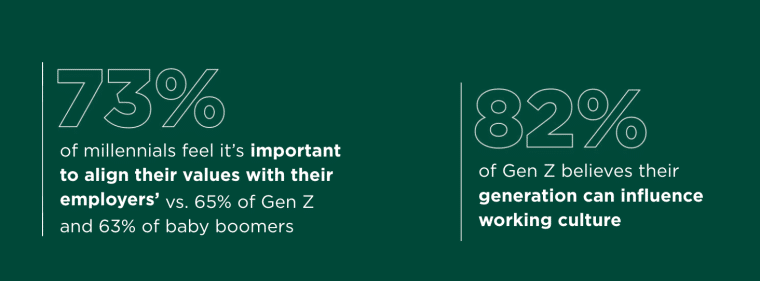
The Monster report stated the top reasons for choosing a job to be:
- Compensation (50%)
- Meaningful work (42%)
- Safe environment (35%)
The survey showed that younger job seekers placed a heavier focus on long-term marketable skills while older job seekers placed more emphasis on enjoying competitive compensation and having a stable work environment.
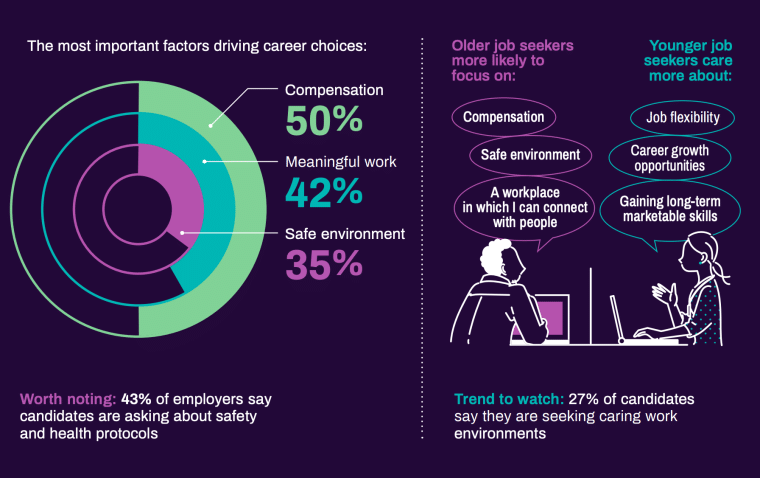
According to McKinsey’s The State of Organizations 2023, 40% of hiring managers were willing to customize individual welfare packages, such as flexible hours and vacation days, to retain talents, and 36% offered leadership training to better provide and receive feedback.

In 2023, Microsoft announced unlimited vacation days for its US employees, giving them more flexibility in enjoying a desirable work-life balance. Workers can take as many days off as they wish, given that assigned tasks are delivered on time.
International companies like Apple, LinkedIn, and Netflix have all introduced this incentive among more senior positions as part of their welfare packages to attract talent.
10. Artificial Intelligence is Becoming Part of the Hiring Process
AI is shaping the latest recruiting trends in 2025. Recruiters are racing to get the most out of the new technology to get ahead in the talent acquisition game. From predictive analytics to actual decision-making, AI has transformed the way businesses hire talent.
Tidio talked to over 1,000 HR people and job applicants to find out people’s take on AI in recruiting trends.
95% of people believed AI would be more involved in the recruitment process in aspects like:
- Screening candidates (63%)
- Finding other potential candidates available on the job market (56%)
- Writing job descriptions (46%)
- Carrying out initial interviews (37%)
- Handling the entire talent acquisition process (31%)
AI took up tasks in different parts of the seven hiring stages that would traditionally be performed by HR leaders, allowing companies to allocate resources to higher-value-added duties.
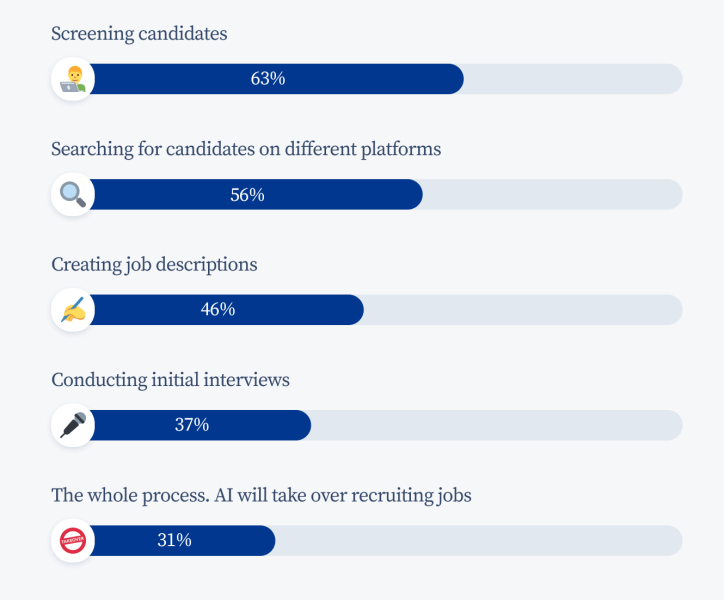
59% of respondents agreed that AI helped remove unintentional biases individual recruiters might have. It created better chances for people of all races, ages, and genders to get hired for their professional qualities.
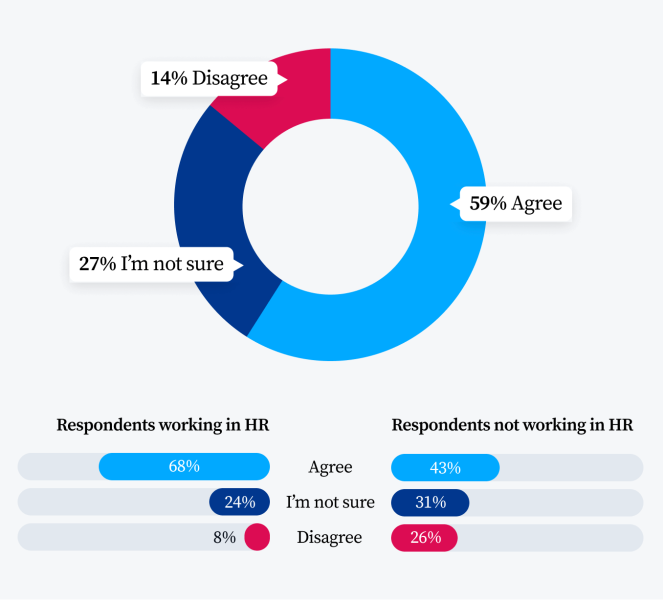
79% of recruiters thought human intervention would not be needed in the future during the seven hiring stages, although 56% of candidates believed hiring decisions should ultimately be made by humans.
Candidates were worried that, without the chance to present themselves in person, they would not get a fair chance in the competition due to AI bias.
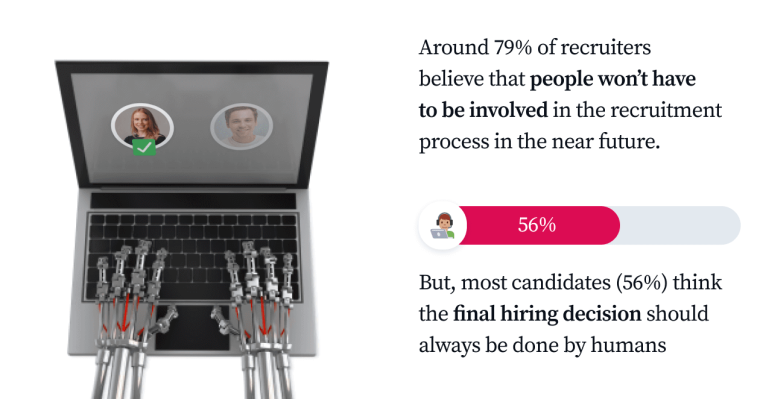
Overall, 90% of people stated that AI could be manipulated by candidates to land a position if human recruiting efforts were completely removed. Applicants who knew the system could target keywords in their resumes, create fake profiles, and feed key data points to AI to get selected for the position.
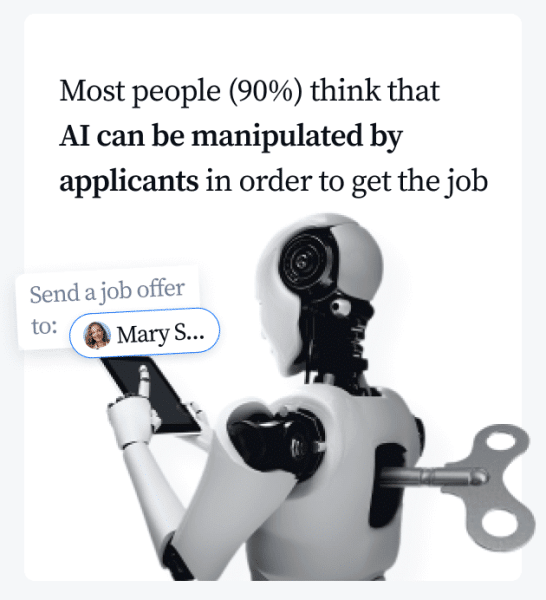
The biggest limitations of using AI in talent acquisition included:
- Overlooking certain soft skills and atypical qualities (21%)
- Algorithm bias (18%)
- Manipulation by candidates (16%)
- Important aspects not considered by AI developers (16%)
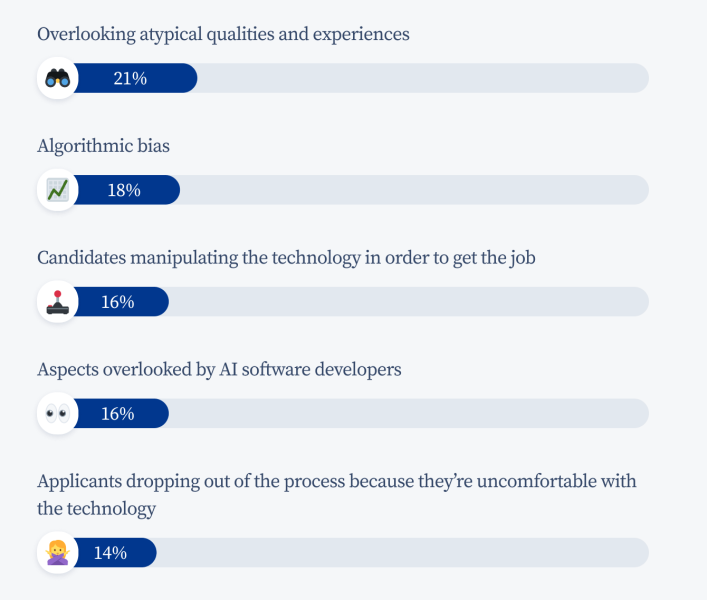
11. NDAs are No Longer Legal Shields To Hide Companies’ Wrongdoings
Non-disclosure agreements (NDAs) are a common practice in the business world. To keep business secrets, companies often ask employees to sign these contracts that legally prevent signees from revealing the sensitive information included therein (with some exceptions).
However, many employees feel they have lost the right to expose the wrongdoings of the company after signing.
A 2022 research conducted by the charity Pregnant Then Screwed found that:
- 90% of respondents who signed an NDA after experiencing discrimination felt they had no other choice.
- 72% said signing an NDA had an adverse impact on their mental well-being.
- 78.5% believed their employers had repeatedly used NDAs to hide wrongdoings.
At the end of 2022, President Biden signed the Speak Out Act, forbidding the use of NDAs to hide illegal or violent acts such as sexual harassment and racial discrimination.
The act aims to stop companies from using NDAs as a legal shield. More workers will be protected and allowed to speak up if their legal rights are violated.
12. Paid Trials and Internships are Expanding
University students or fresh graduates are doing more internships in 2025. Internships, or trials, are a great way for HR managers to access a candidate’s soft skills and industrial knowledge before offering a full-time job opportunity.
According to the 2023 Internship and Co-op Report produced by the National Association of Colleges and Employers, the conversion rate from internship to employee for the 2022 period grew 57.6%, compared to 2022.
Recruiting teams have begun to see internships as a transition period for potential candidates. Interns can also experience the work culture and duties before committing to a full-time role, thus lowering the turnover rate and boosting employee experience.
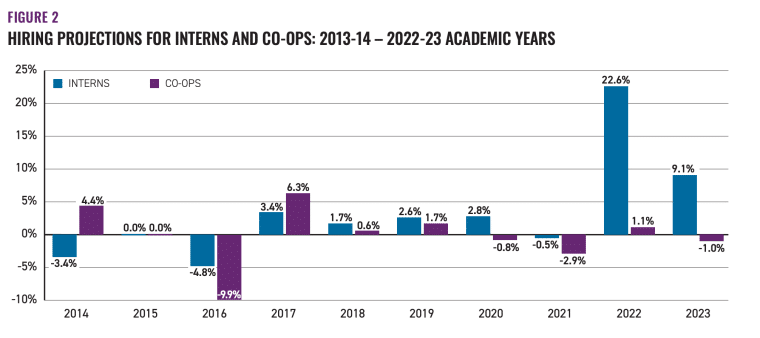
Some companies even require an internship before hiring. A 2019 Chegg Internships report stated that major employers like US Congress, PwC, EY, KMPG, and Deloitte, required most new hires, especially those without previous work experience, to take up internships first.
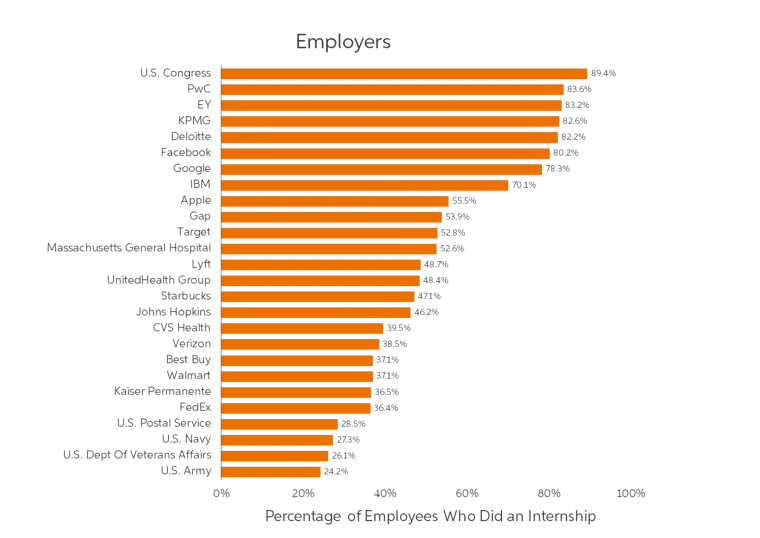
University graduates with relevant work experience are more likely to get hired – but remember that experience trumps a degree. To stay competitive, students can apply for internship opportunities to gain real work experience and expand their networks during their school years.
13. Diversity, Equity, and Inclusion is Still Vital
Diversity, equity, and inclusion (DEI) are the future business model that drives success and improves employer branding. In the past few years, rising awareness of workplace discrimination and a cultural shift favoring identity politics have caused companies to put building an inclusive work environment as a top priority.
The Monster report found that globally, 37% of recruiters focused on ethnic minorities when hiring to increase diversity.
In France, recruiters (29%) placed a heavier emphasis on people with disabilities than the rest of the world (19%). In the Netherlands, women (41%) and parents (42%) were offered more DEI initiatives whereas in the US, 30% of recruiters supported hiring veterans or family members of veterans.
While there were differences in the DEI groups focused on, most companies around the world were incorporating more diversity and inclusion in their hiring trends.
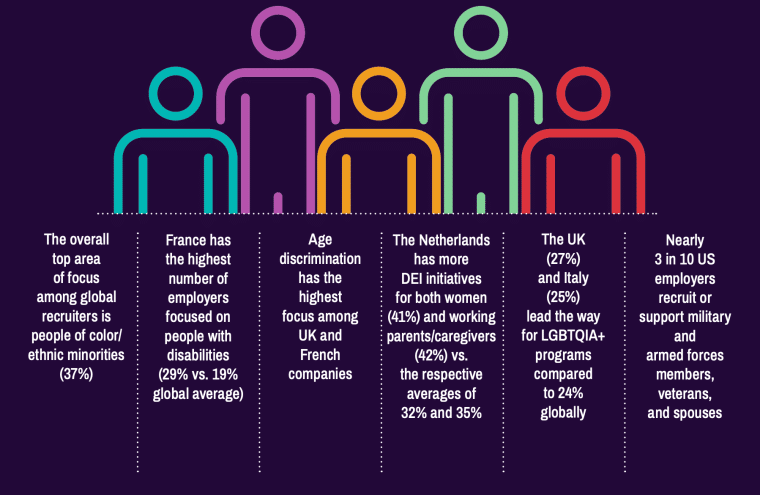
The Future of Hiring and Recruiting
As the job market becomes fiercer than ever, companies are adopting these recruiting trends to attract top talent, build hiring flow, and maximize recruitment efforts.
To prepare yourself and your team for upcoming HR trends, here are a few things to expect:
- AI will be more widely used in analyzing KPIs during the seven hiring stages.
- More HR managers will be willing to customize individual welfare packages for talent.
- Companies will place a heavier focus on creating an inclusive environment with a diverse workforce.
- More business leaders will prefer a hybrid model to stay cost-effective and draw more top-quality applications.
- Stricter laws may be enforced to forbid companies from silencing employees in legal disputes to protect workers.
